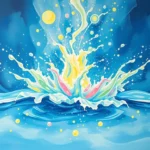
Dreams have long fascinated humanity, serving as a window into our subconscious minds. Among the myriad of dream themes that people experience, the concept of dancing ghosts stands out for its unique blend of the ethereal and the emotive. Such dreams can evoke feelings of nostalgia, fear, or even joy, compelling individuals to ponder their meanings. The relevance of these dreams lies in their ability to connect us with our past, our fears, and our desires. Exploring the symbolism of dancing ghosts can provide profound insights into our emotional and psychological landscapes.
Symbolism and Meaning
The imagery of dancing ghosts in dreams carries a rich tapestry of meanings and interpretations. At its core, the ghost symbolizes the past—memories, unresolved issues, or relationships that linger in our lives. When these spirits are depicted as dancing, it introduces a dynamic element that suggests movement, change, and perhaps even acceptance. The act of dancing can signify a release, a celebration, or a confrontation with what has been haunting us.
From a more psychological perspective, ghosts often represent parts of ourselves that we have not fully accepted or integrated. They can be manifestations of regret, loss, or grief. When these entities engage in a joyful dance, it may indicate that the dreamer is beginning to reconcile with these feelings. The dance transforms what is typically a somber symbol into one of lightness and freedom, suggesting that the dreamer is ready to embrace their past rather than be consumed by it.
Another interpretation revolves around the idea of communication. Dancing can be seen as a form of expression, and in dreams, it may symbolize the desire to communicate with those we have lost or with aspects of ourselves that we have neglected. The presence of dancing ghosts could imply that there are messages from the past that need to be acknowledged and expressed in our waking lives.
Furthermore, the setting of the dance can significantly alter its interpretation. For instance, a grand ballroom may evoke feelings of nostalgia and celebration, while a more intimate setting could suggest personal memories and emotions tied to specific individuals or experiences. The mood of the dance—whether it feels joyful or melancholic—also plays a critical role in determining the dream’s meaning.
Key Scenarios and Variations
The experience of dancing ghosts can vary widely, leading to different interpretations based on the context and details of the dream. For instance, if the dreamer finds themselves dancing with the ghosts, this could indicate a desire for connection or reconciliation with the past. It may signify that the dreamer is coming to terms with previous relationships and is ready to incorporate those experiences into their current life.
Conversely, if the ghosts are dancing around the dreamer without direct interaction, it may suggest feelings of being overwhelmed by the past. The dreamer might feel haunted by memories or unresolved issues that they have not yet addressed. This scenario could signal a need for self-reflection and the importance of confronting these lingering emotions.
In scenarios where the dancing is chaotic or unsettling, it can be indicative of inner turmoil. The ghostly figures may represent aspects of the dreamer’s psyche that are in conflict—feelings of anxiety, fear, or confusion about the future. This could be a call to explore these emotions more deeply and seek resolution.
Another fascinating variation occurs when the dance takes place in an unusual setting, such as a cemetery or an abandoned house. These locations can enhance the dream’s symbolism, suggesting that the dreamer is wrestling with deep-seated issues related to mortality, legacy, or unresolved trauma. The juxtaposition of a lively dance in a typically somber space can highlight the conflict between joy and sorrow, urging the dreamer to find balance.
Finally, the presence of other dancers alongside the ghosts can enrich the dream’s narrative. If the dreamer is surrounded by friends or family, it might indicate the importance of support systems in dealing with the past. On the other hand, if the dancers are strangers, it may suggest that the dreamer is exploring unfamiliar aspects of themselves or their history.
Real-Life Connections and Takeaways
Understanding the symbolism of dancing ghosts can offer valuable insights into one’s waking life. These dreams often serve as reflections of our emotional states, urging us to confront unresolved issues or embrace our past experiences. As such, they can be a catalyst for personal growth and healing.
To connect these dreams to real-life situations, readers are encouraged to engage in a process of self-reflection. Consider the emotions felt during the dream: Were they predominantly positive, negative, or a mix of both? Reflect on any recent events or situations in waking life that might parallel the themes of the dream. Are there relationships or experiences from the past that still evoke strong emotions? Taking time to journal about these feelings can help clarify their significance and inspire action.
Additionally, it may be beneficial to explore creative outlets as a means of expression. Just as the ghosts dance in the dream, engaging in activities like writing, painting, or dancing can facilitate emotional release and help process complex feelings. This creative expression can serve as a bridge between the past and present, allowing the dreamer to honor their experiences while moving forward.
Moreover, consider speaking with trusted friends or a therapist about the dream and its implications. Conversations about dreams can often reveal hidden insights and foster deeper connections with others. By sharing these experiences, readers may discover that they are not alone in their feelings and can gain new perspectives on their situations.
Ultimately, the appearance of dancing ghosts in dreams invites personal exploration. It encourages individuals to confront their pasts, embrace their emotions, and seek harmony in their lives. As you reflect on your own experiences, ask yourself: What messages might these dancing spirits be trying to convey? How can you integrate the lessons of the past into your present and future?
In conclusion, dreams of dancing ghosts are rich in symbolism and meaning, offering profound insights into our emotional landscapes. By exploring the various interpretations and connecting them to our waking lives, we can find deeper understanding and pathways for healing. Embrace these dreams as opportunities for reflection and growth, allowing them to guide you on your journey toward self-discovery and acceptance.







